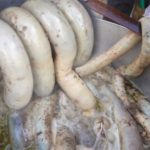Animal offal is a delicacy for many people in Vietnam, and it’s easy to see why. These dishes, often prepared in restaurants and pubs, are tantalizing and loved by many. However, nutritionists caution against overindulgence due to the high levels of unhealthy fats found in animal offal, which can be detrimental to one’s health if consumed in large quantities.
Despite this, it’s noticeable that while pig offal is readily available and sold in abundance in local markets, the same cannot be said for beef offal. So, why is beef offal less commonly sold than pig offal in these markets?
Pig offal is a common sight in daily market stalls, and this is not solely due to its popularity among consumers. The large supply is also linked to the high volume of pork production and consumption in Vietnam. Pork features more prominently in the dietary habits of Vietnamese people compared to beef, and the number of pigs slaughtered daily is significantly higher.
</em></p>
<p>Consequently, even after supplying restaurants and pubs, there is still a substantial surplus of pig offal available for sale in markets and online groups, catering to those who wish to prepare these dishes at home.</p>
<p>In contrast, the number of cattle slaughtered is far lower than that of pigs, resulting in a limited supply of beef offal. Beef offal is also in high demand among restaurants as it is used to create unique and appealing dishes such as grilled beef offal and beef offal hot pot. As a result, it is often purchased directly from slaughterhouses by these establishments, leaving little to be supplied to local markets. This explains why pig offal is readily available, while beef offal is not commonly sold in markets.</p>
<p><img decoding=)
Beef offal is often purchased by restaurants and pubs, where it is transformed into delectable dishes like this. (Image: Yumchinesefood)
Who Should Limit Their Consumption of Offal?
While offal dishes are undoubtedly tasty, it is important to exercise moderation to reduce the risk of obesity, high cholesterol, gout, and other health issues.
Here are some individuals who should refrain from or limit their consumption of offal:
– Those with a weak digestive system: Offal contains high levels of bacteria, and improper handling or inadequate cooking can lead to diarrhea, dysentery, abdominal pain, and vomiting.
– Individuals experiencing fatigue or illness, or those with a weakened immune system, should also avoid offal as it may increase the risk of infection and exacerbate their condition.
– Pregnant women: Offal poses a higher risk of bacterial, viral, and parasitic infections, which can be dangerous for both the mother and the unborn child.
– Individuals with obesity, fatty liver, or cardiovascular diseases: Offal is high in fat and cholesterol, which can worsen these conditions and increase the strain on the cardiovascular system.
– People with gout: Consuming pig offal can aggravate the symptoms of gout.
How to Boil Pig Offal to Make it White and Crispy
Prepare a bowl of cold water with a few drops of lemon juice or use cold water mixed with a small amount of alum. Bring this mixture to a boil and then let it cool down.
The key to delicious offal is to boil it in already boiling water. This ensures that the offal is cooked just right and retains a crispy texture.
Let the offal cook in the boiling water for 2-3 minutes, until it turns pink, and then remove it from the heat and soak it in the prepared cold water mixture. This process not only keeps the offal crispy but also gives it a beautiful white color without any unsightly darkening. Typically, the total cooking time, from adding the offal to the boiling water to removing it, is around 7-10 minutes, depending on the quantity of ingredients used.
For the small intestines, simply boil them for a few minutes and then turn off the heat. Remove them from the hot water and immediately place them in a bowl of cold water with alum and a few ice cubes to cool down. Once cooled, remove them from the water and cut them into bite-sized pieces.
In summary, the key to achieving white and crispy offal is to boil it quickly and remove it from the heat as soon as it is cooked. Leaving it in the water for too long will result in a chewy texture.
According to VTC News


































